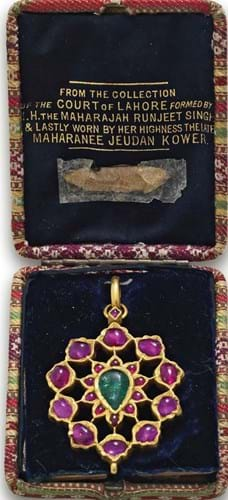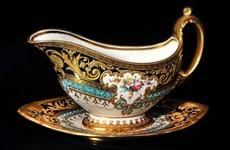
Diamond and emerald set gold pendant from the collection of Maharani Jindan Kaur – £110,000 at Bonhams.
It was one of the court jewels seized by the British when they took control of the Treasury in Lahore in 1849 that were sold by auctioneers Messrs Lattie Bros in the Lahore Fort over five days from November 28 to December 2, 1850.
Many pieces were later boxed by Bombay jeweller Frazer & Hawes and sent to London for sale by Garrards of Regent Street. The inside of the lid to this box is inscribed From the Collection of the Court of Lahore formed by HH The Maharajah Runjeet Singh & lastly worn by Her Highness the Late Maharanee Jeudan Kower.
Pieces such as this hold a special value in the Sikh community. As the 17th wife of Maharajah Ranjit Singh (1780-1839) and mother and regent to the young Maharajah Duleep Singh, ‘Rani Jindan’ had been a thorn in the side of the East India Company.
After waging both the First and Second Anglo-Sikh Wars of 1846- 49 she fled to Nepal and was not reunited with her son until 1861. By then he was living the gilded cage life of a Scottish laird.
Two pieces of Indian jewellery in similar Frazer & Hawes cases were sold at auction by Bonhams in 2018 – a pair of gold pendant earrings (£140,000) and an emerald and seed pearl necklace (£150,000) – and last year a diamond and emerald set forehead pendant (chand-tikka) made £105,000.
This openwork foliate pendant, probably made in Lahore in the first half of the 19th century, continued the strong series of results, selling in London at £110,000.
Company School art
A good example of mid-19th century Company School art was eagerly contested at Roseberys’ (25/20/12% buyer’s premium) sale of Antiquities, Indian & Islamic Art in London on April 1.
This 10 x 9in (26 x 22cm) painting of a monkey, c.1850, is based on a Mughal painting of the same subject. The original, attributed to ‘the Stipple Master’ and dated to 1705-10, is held by the Art Institute of Chicago. According to an inscription on the reverse, the monkey was named Husaini and owned by Daud Khan Panni, a faujdar (military commander and territorial administrator) who served the Mughal emperors from Aurangzeb (1658-1707) to Farrukhsiyar (1713-19).
In this later version some details, such as the grass and rope from the monkey’s neck, are removed in favour of a simplicity characteristic of the period. A striking and well-painted image guided at £2000-2500, it sold at £17,000.
A miniature of Radha and Krishna on a bed painted in Garhwal, c.1800-20, came for sale by descent from William and Mildred Archer. Worked in opaque pigments heightened with gold on a folio measuring 12 x 9in (29 x 23cm), it was published many times in articles penned by both collectors including in William Archer’s Visions of Courtly India (1976). Although the painting does not come from any known Gita Govinda series, it reflects the poem’s concluding stanzas: In the morning she rose disarrayed and her eyes betrayed a night without slumber; when the yellow-robed God, who gazed on her with transport, thus meditated on her charms in his heavenly mind. It sold at £18,000 (estimate £5000-7000).
Celebrated silversmith
By the end of the 19th century, Indian decorative arts were readily available in the more fashionable stores of London.
The celebrated Indian silversmith Oomersi Mawji & Sons took part in the Exposition Universelle in Paris in 1878 and sold its work through Liberty & Co.
While Mawji died in 1890, his sons continued the business until c.1930, producing the popular Kutch silver that melded local decorative styles with European forms.
There was a time when this material (much like Chinese export silver of a similar period) was outsold by English silver at a ratio of three or four to one but today there is more interest in the exotic.
The Fine Sale at Keys (20% buyer’s premium) in Aylsham on March 23-25 included a splendid late 19th century punch bowl by Oomersi Mawji & Sons weighing 93oz. Chased and embossed with flowers, scroll work and hunting scenes with the handles formed as winged bird’s heads, it came complete with its ebonised socle and a purple velvet lined travelling case.
As a fine example of the company’s work this bowl took £18,400 (estimate £8000-12,000).
















